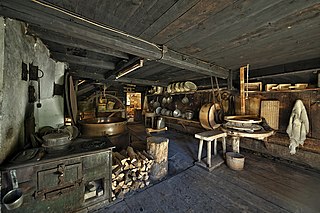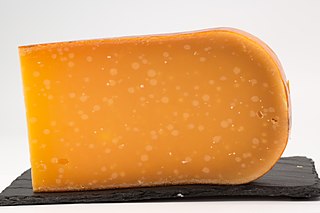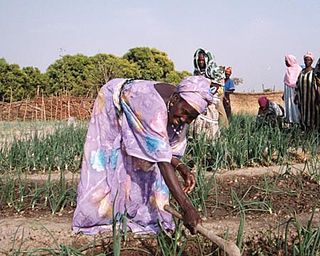
A dairy is a place where milk is stored and where butter, cheese and other dairy products are made, or a place where those products are sold. It may be a room, a building or a larger establishment. In the United States, the word may also describe a dairy farm or the part of a mixed farm dedicated to milk for human consumption, whether from cows, buffaloes, goats, sheep, horses or camels.

Beemster is a former municipality in the Netherlands, in the province of North Holland. The Beemster is the first so-called polder in the Netherlands that was reclaimed from a lake, the water being extracted from the lake by windmills. The Beemster polder was drained between 1609 and 1612. It has preserved intact its well-ordered landscape of fields, roads, canals, dykes and settlements, laid out in accordance with classical and Renaissance planning principles. A grid of canals parallels the grid of roads in the Beemster. The grids are offset: the larger feeder canals are offset by approximately one kilometer from the larger roads.

Gouda cheese is a sweet, creamy, yellow cow's milk cheese originating from the Netherlands. It is one of the most popular cheeses worldwide. The name is used today as a general term for numerous similar cheeses produced in the traditional Dutch manner.

Cottage cheese is a curdled milk product with a mild flavor and a creamy, heterogenous, soupy texture. It is made from skimmed milk by draining curds, but retaining some of the whey and keeping the curds loose. An important step in the manufacturing process distinguishing cottage cheese from other fresh cheeses is the adding of a "dressing" to the curd grains, usually cream, which is largely responsible for the taste of the product. Cottage cheese is not aged.

Leyden, from Dutch: Leidse kaas, is a semi-hard, cumin and caraway seed flavoured cheese made in the Netherlands from cow's milk. It is made both in factories and on farms, historically in the Leiden area.

Colby is a semi-hard orange cheese made from cow's milk. It is named after the city of Colby, Wisconsin, US, where it was first developed in 1885 and quickly became popular.

Paneer, also known as ponir, is a fresh acid-set cheese common in the Indian subcontinent made from full-fat buffalo milk or cow milk. It is a non-aged, non-melting soft cheese made by curdling milk with a fruit- or vegetable-derived acid, such as lemon juice.

An agricultural cooperative, also known as a farmers' co-op, is a cooperative in which farmers pool their resources in certain areas of activity.

Camel milk is milk from female camels. It has supported nomad and pastoral cultures since the domestication of camels millennia ago. Herders may for periods survive solely on the milk when taking the camels on long distances to graze in desert and arid environments, especially in parts of the Middle East, North Africa and the Horn of Africa. The camel dairy farming industry has grown in Australia and the United States, as an environmentally friendly alternative to cow dairy farming using a species well-adapted to arid regions.

Cheese is a dairy product produced in wide ranges of flavors, textures, and forms by coagulation of the milk protein casein. It comprises proteins and fat from milk. During production, milk is usually acidified and either the enzymes of rennet or bacterial enzymes with similar activity are added to cause the casein to coagulate. The solid curds are then separated from the liquid whey and pressed into finished cheese. Some cheeses have aromatic molds on the rind, the outer layer, or throughout.
Vlaskaas is a Dutch Gouda cheese with a firm, yet creamy texture and a sweet, sharp flavor. Vlaskaas is made under the Beemster brand by the farmer-owned cooperative, CONO Kaasmakers in the Netherlands. The name translates to "flax cheese" but there is no flax in the cheese. The name is in honor of the historic importance of flax in the Dutch economy.

There are many different types of cheese. Cheeses can be grouped or classified according to criteria such as length of fermentation, texture, methods of production, fat content, animal milk, and country or region of origin. The method most commonly and traditionally used is based on moisture content, which is then further narrowed down by fat content and curing or ripening methods. The criteria may either be used singly or in combination, with no single method being universally used.

Purmer is a polder and reclaimed lake in the Netherlands province of North Holland, located between the towns of Purmerend and Edam-Volendam. It is also a village located in the municipalities of Waterland and Edam-Volendam.

Cheese ripening, alternatively cheese maturation or affinage, is a process in cheesemaking. It is responsible for the distinct flavour of cheese, and through the modification of "ripening agents", determines the features that define many different varieties of cheeses, such as taste, texture, and body. The process is "characterized by a series of complex physical, chemical and microbiological changes" that incorporates the agents of "bacteria and enzymes of the milk, lactic culture, rennet, lipases, added moulds or yeasts, and environmental contaminants". The majority of cheese is ripened, except for fresh cheese.
Ellsworth Cooperative Creamery is a producer of cheese curds located in Ellsworth, Wisconsin. It has retail locations in Ellsworth and Menomonie, Wi. The cooperative ships throughout the United States and Ellsworth Cheese Curds are found in grocery store chains in the upper Midwest. Ellsworth Cooperative Creamery is also a milk processing and whey drying plant.

Dairy is a major industry in the state of Wisconsin. Being known for its dairy production, the state is often called "America's Dairyland." The industry is prominent in official state symbols—being displayed on the state's license plates, state's slogan, and on the state quarter.

Commercial cheesemaking in Wisconsin dates back to the nineteenth century. Early cheesemaking operations began on farmsteads in the Michigan and Wisconsin territories, with large-scale production starting in the mid-1800s. Wisconsin became the largest producer of cheese in the United States in the early 1900s, and in 2019 produced more than 3.36 billion pounds of cheese of more than 600 varieties, accounting for 26% of all cheese made in the country that year.















